Edmond Parizo
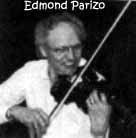

Hommage À Nos Ancêtres – Edmond Parizo Son Violon Vol III, EP-03, 1993
Edmond Parizo, violon; Alain LaPointe, piano
Tracks: Reel L’oisseau monqueur; Reel Hommage
à nos Ancêtres; Reel D’Edmond; Reel de La Bottine; Swing la
détendre; Reel de la sauterelle; Reel du Pendu les 7 parties; L’oiseau
jaune (Yellow Bird); Cha Cha le volleur de pervenche; Swing In The Mood;
Valse pour un baiser d’amour; Cha Cha que calor la vida; Samba Willing
Samba; Swing fil d’argent
Edmond Parizeau et Ses "Paper Makers" du Saguenay
Tracks: Reel Des Robineux* / Reel Des "Paper Makers"*
Square Dances, Arc 553
Victor Pasowisty, fiddle; Jim Fisher, caller; Eddie Stock, banjo; Roy Anthony, bass; Bill Mankiss, piano and accordion; Mike Crosty, drums
Tracks: Sitting Bull Reel; Silver Dollar
Waltz; Spider Island Jig; Churning Butter Reel; Cold Springs Breakdown;
Crossing On The Ferry; Atlantic Polka #6; Mountain Road Jig; Don Messer’s
Breakdown; Waltz Promenade
Victor Pasowisty was born in Mountain Road, Manitoba and began to play the violin at the age of 12. Victor entered the Canadian Olde Tyme (sic) Fiddling contest at Shelburne, Ontario in 1954 and impressed those in attendance with his technique with the fiddle and bow. In 1955 Victor returned to Shelburne and won the coveted Shelburne Cup, for placing first in a field of the top Olde Tyme Fiddle players of America. To date Victor Pasowisty is the only contestant to reach the finals of this very competitive event for six years running.
Jim Fisher is of Irish-Canadian and English parentage, and was born in Harwood, Ontario, a small village in Northumberland County. In 1954 he organized the Canadian Olde Tyme Callers Association and was President in 1954 and 1955. His calling career began in the late 1930s and early ‘40s in the Muskoka district of Northern Ontario. Dances have been called by him in Saskatchewan, New York State and almost every section of Ontario.
In the past 12 years that Victor and Jim have worked together, they have accumulated a repertoire of traditional music and calls second to none. So, roll back the rug, square your sets and enjoy the fine music of Victor Pasowisty and The Homesteaders with special guest Jim Fisher, Canada’s leading square dance caller.
Direction: Dan Bass
Tracks: Mayflair Polka*; Hory Karpaty; Cheremshyna;
My Sweet Katrusia; Merry Go Round Schottische; Natalka; Trembita; Smerichky;
Blondies Polka; Dear Mother of Mine; Those Were The Days; Ruby Lips
Take a musical journey with Victor Pasowisty to the Trembita Room at the Mayfair Inn in Toronto. A uniquely designed room depicting the culture of the Ukrainian Hutzulls in the Carpathian Mountains, it was the Trembita that inspired Pasowisty to once again compose and perform violin melodies with a very original flavour that will surely be woven into the great Canadian mosaic of many cultures.Dymtro Kupiak of the Trembita Room proudly claims: “Victor Pasowisty is the only performer who has been able to re-create suitable music for this authentically designed Ukrainian dining room where visitors from Europe, South America, Mexico, Australia and The United States have come to hear him play.”
Victory Pasowisty, a Canadian Olde Tyme Fiddle Champion, was born in Mountain Road, Manitoba, and is of Ukrainian and Polish descent. he is a popular guest artist on Canadian radio and TV shows and has recorded seven best selling albums.
So popular has Victor Pasowisty become in ten months at the Trembita Room that he has been held over for another year. This recording features the original composition and Ukrainian favourites of the past and present, that have made “Victor Pasowisty at the Trembita room” an irresistible attraction for thousands of music lovers.
Victor Pasowisty, fiddle; Bill Mankiss, piano, accordion; Greg Mankiss, guitar, mandolin, bass; Lorne Prince, stand-up bass; Paul Hutton, drums; Lynn Russwurm, rhythm guitar
Produced by Lynn Russwurm and Victor Pasowisty; Engineer: Harry Busby; Recorded at Ernie King Studios
Tracks: School Patter (tyrolse) - USA; Chovnik
(Boat Song) - Ukraine; Rocky Mountain - Canada; Oslo Waltz - Sweeden; All
Those Endearing Young Charms / Come Back To Ireland / Mountains of Mourn
/ Gentle Maiden - Ireland; Cuckoo Waltz - Austria; De Molen Draait (The
Windmills Turning) - Holland; Natcha - Romania; Varsoviana Waltz - USA;
Wishing Well / Whose Girl Are You - Poland; Tra Veglia E Sonno - Italy;
Poor Girl - Canada; Blue Skirt Waltz - Czechoslovakia; Finnish Waltz -
Finland; Ashokan Farewell - USA; Bluejeans and Gingham - USA
This collection of waltzes from around the world was chosen by Victor to commemorate the arrival in the new world by his ancestors 100 years ago and co-incides with the family reunion being held in Western Canada.
'It's A Saturday Night Barn Dance'
compilation, Rodeo Records RLPCD 8045, circa 1996
track 20: Jason's Tune
This is written by Victor who was winner of the Shelburne Fiddle Contest in 1955 & is taken from an album on Rodeo
Ron Paxton and the Foothill Stompers, Aura Records WRC1-1240 - circa 1980
Ron Paxton, mandolin, guitars, banjo, belt buckle, bass; Alex McDonald, violin, washboard; Donna Otte, piano, auto harp; Gerri Rothe, spoons
Produced by Ron Paxton; Engineered by Michael Chursinoff and Gerri Rothe; Recorded at Jonathon Recording Studio, Calgary AB
Tracks: Westphalia Waltz; Black Velvet Waltz;
Karlstad Schottische; Banjo Gallop; Rock Valley Jig; Crooked Stove Pipe;
Whispering; Country Waltz; Oh! Dem Golden Slippers; Military Schottische;
The Old Red Barn; Year of Jubilo
The Foothill Stompers started when Donna Otte, Alex McDonald and Walter Wandzura, got together on occasion, for jam sessions. They were short a bass player, and Ron Paxton entered the scene. They played local functions, in Calgary with Ron’s help, for about two years. The band discontinued for one year, due to the death of Walter Wandzura.Ron, Alex, and Donna then carried on, with Ron Paxton assuming a more prominent role, on the mandolin. Ron feels that old time music still has its role now, and in the future, and as a result, we have this album.
This album is dedicated to Walter A. Wandzura: 1931 - 1978.
‘Till We Meet Again’
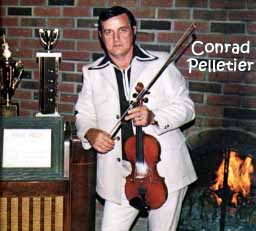
Un Champion… un Violon… Vol 1, Reserve TCR 1050, circa 1980
Tunes: Tennessee Breakdown; Walker Street Reel; Dundee Reel; Big John McNeil; Angus Campbell; Devil’s Dream; Top of Cork Road; St. Patrick’s Jig; Belles Favorites; Rocking Chair; Bottom Hill’s Mary

Walkin’ Up Town, Oak 168 - 1994
Recorded at Ambassador Studios, Oshawa, ON
Tracks: Walkin’ Up Town; Bowin’ The Strings; High Level Hornpipe; Billy In The Low Ground; King Robert The Bruce; Banks; Back Up And Push; Orange Blossom Special; White River Stomp; Soldier’s Joy; Twinkle Twinkle Little Star; Hamilton County Breakdown; Maple Sugar; Cotton Eyed Joe
Per Norgaard, fiddle; Bob Arbuckle, fiddle; Verner Mikkelson, accordion; N. Roy Clifton, piano; Ronald Duncan, percussion
Recorded by Edith Fowke.
Tracks: Gentle Shepherd - Mrs. Jamieson’s Jigs or Teviot Bridge; Haste to the Wedding - Major MacKie’s jigs; Lannigan’s Ball; The Haymakers; Verner’s Jig*; Tuggerman’s - Off She Goes jigs; The Crooked Stovepipe - The Rakes of Mallow reels; Glissé à Sherbrooke - The Long-Eared Mule reels; Ragtime Annie; The Logger’s Breakdown - The Frenchman’s Reel; Highroad to Linton - The Devil’s Dream
Introduction:
This record is designed for the use of square-dance groups who have their own callers but lack musicians. The music is that used in eastern Canada and the United States: an older and more traditional style than that used for western square dances. The tempo is somewhat slower than that found in western music: the basic rate is M. 120 (on a metronome - ed.), although there is some variation, ranging from 120 - 128. The leader, Per Norgaard, feels that the character of some pieces demands a slightly faster pace, and in general the group tends to adapt its speed to the mood.The dances have been grouped according to their rhythm: all the 6/8 pieces, or jigs, are on Side I, and the 4/4 pieces, or reels, are on Side II. Thus, if a caller has not finished a particular call by the end of one band, he can let the record run onto the next band, for it will be in the same tempo. Normally, in eastern dances, it is the custom to use music in 6/8 time for the first and second changes, and in 4/4 time for the third change. This helps to create a climax of activity at the end of the breakdown, for 4/4 is a much more lively tempo than 6/8.
The dances given here are almost all traditional, and most of them are British in origin. For example, “The Highroad to Linton”, “Teviot Bridge”, and “Off She Goes”, “Haste To The Wedding”, and “The Haymakers” are English; “The Rakes of Mallow” and “Lannagan’s Ball” are Irish. A few, such as “Ragtime Annie” and “The Long-Eared Mule” are American, while “The Logger’s Breakdown”, “Tuggerman’s Jig”, and “French’s Reel” are Canadian, and “Glissé à Sherbrooke” is French-Canadian. Verner Mikkelson is, of course, responsible for “Verner’s Jig”.
The musicians have been playing together for local square dances around Toronto for about six years and in this record they have tried to reproduce their actual performance at a dance. That involves a certain amount of improvisation each time a piece is played. In other words, they do not play any predetermined arrangement, but introduce variations on the theme spontaneously, as jazz musicians do. this leads to a certain unevenness in spots, but it does re-create the atmosphere that would exist at an actual dance.
And, as they do for dancing, the group frequently combines two different tunes in a single band. As long as the tunes have the same rhythm, this does not affect the dancing or the calling, and it serves to avoid the monotony which might be felt if the same tune were continued for the whole length of a set.
Per Verner, and Ron, who are all in their twenties, have been playing together ever since they left high school. Per and Verner are Danish Canadians. By occupation, Per is a geophysicist, Verner a motor mechanic, Ronald a commercial artist, and Roy a school teacher.
It was necessary to re-record three pieces after Per had left Ontario on a field trip, and for this session he was replaced by another fiddler who sometimes plays with the group: Bob Arbuckle. The tunes for which Mr. Arbuckle was the fiddler are “Teviot Bridge”, “Verner’s Jig”, and “Lannagan’s Ball”.
Normally, the pianist, N. Roy Clifton, acts as caller for the group, as he did on their previous record, “Honour Your Partners!” (Folkways FW 8825). He has since tried out these recordings as a background for calling at dances, and reports that the music “has a good beat to call to, and that it certainly sets the dancers’ toes going”.
Edith Fowke
Notes For New Callers
This is not a treatise on calling, but a hint or two to start a person off, since in any square-dance group, if the old-time tradition is to be kept up, any gent present should be able to call, if asked. Square dance tunes are written either in 6/8 time (jigs) or 4/4 time (reels), and the caller must first be clear in which tempo the music he is calling to is written.
To Start:
Take a simple call, to begin with, one with few words and no pauses. My usual suggestion to new callers is:
(6/8 - Haste To The Wedding)
Around that couple
Take a peek
Into the centre
Swing your sweet
Around that couple
Peek once more
And into the centre
Circle four
Ont to the next
And take a peek, etc.Memorize the words. Play the music until it is familiar. Say the call, fitting the accents marked in the call to the accents of the music, till you call to the rhythm as if it were second nature.
Use the simplist introduction:
Honour your ladies
Corners address
All join hands
And away to the west,and the commenest break:
Allemand left
Your corners all
Right to your lady
Grand chain.Learn these in the same way. Write them down on a card for re-assurance, but don’t look at the card at all, except in emergency. It is all thoroughly memorized, and your attention should be on the dancers.
Pauses:
Other calls, as those given below, are not called continuously, but with rests left for the completion of the movement. This accustoms the caller to calling and pausing, as he must do later, to accommodate the call to sets dancing at different speeds.
Six-Eight Time:
In 6/8 time there are six beats in a bar, with a strong accent on the first and fourth beats. The words that should fall on these beats are marked with a dash in the call below. This tempo is more commonly used for first and second changes. In this call, as in many old-time calls, the words fill four beats (two bars) and four beats are allowed in which the dancers complete the movement without call, during which it is wise for the beginning caller, at first, to count four. Here again, call plus pause should provide enough time for dancers to do the movement, so that the caller’s attention need not be distracted from his timing by having to accomodate his call to slow sets. Words or figures in brackets are the caller’s counting to himself.
Introduction: Verner’s Jig
Héad four círcle fóur
(one two three four)
Síde fóur círcle fóur
(one two three four)
Táke your lády prómenade
(count one to twelve)Change:
Head cóuple go ríght and círcle fóur
(One two three four)
*Ríght hand úp and fórm a stár
(one two three four)
Báck by the léft, but nót too fár
(one two three four)
Ríght to the lády behínd your báck
Léft to your ówn and prómenade ónÓn to the néxt and círcle fóur
(one two three four and repeat to *)Ón to the lást and círcle fóur
(One two three four and repeat to *)Break:
Nów you’re hóme, swíng your ówn
(One two three four)
Állemand léft your córners áll
Ríght to your lády, gránd cháin
(count one to twelve)Four-Four Time
In this, there are four beat in a bar, with a strong accent on the first and third beats. This tempo could be used for third, and sometimes for second changes, being more vigorous than 6/8, which is better for the early part of the breakdown.
Introduction: High Road To Linton
Hónour your ládies (one, two)
Córners áddress (one, two)
Fóur ládies círcle léft
(one two three four)
Áll éight círcle léft
(one two three four)Change:
Héad couple ríght and círcle four
(one two three four)
Twó gents twírl with an élbow twírl
Ópposit gírl left élbow twírl
Sáme old gént with the sáme old twírl
And nów your pártners élbow twírl
Círcle fóur, ríght and left thróughÓn to the néxt and círcle fóur
(one two three four - repeat to *)
(there isn’t one in the text - ed.)Ón to the lást and círcle fóur
(one two three four - repeat to *)Break:
Nów you’re hóme, swíng your ówn
(one two three four)
Dósidó on the córners áll
Táke your lády, prómenade áll
(count one to twelve)Suitable Calls For Use With Recorded Tunes:
The call recommended below for each tune is a traditional or old-time call familiar to any dancer, and to be found in nearly any book of calls. Descriptions are therefore not given in this leaflet.
Teviot Bridge - Three by Three
Haste To The Wedding - Round that couple, take a peek
Lannagan’s Ball - Dip and Dive
The Haymakers - Forward up six and right and left through
Verner’s Jig - Star by the Right and Left
Tuggerman’s Jig - Forward up six, fall back eight
The Crooked Stovepipe - Birdie In The Cage
Glísse a Sherbrooke - Cut off six, dosido parterns and corners
Ragtime Annie - Right and Left six
Logger’s Breakdown - Lady round two, gent fall through
High Road To Linton - Two gents turn with an elbow turnN. Roy Clifton
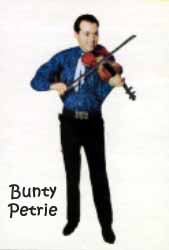
Old tyme Fiddle Favourites, Arc 602
Tracks: Sugar in the Gorge; St Ann’s Reel;
Fire On The Mountain; Maple Sugar; Old Joe Clark; The Mouth Of The Tobique;
Here and There; Twinkle, Twinkle Little Star; Arkansas Traveller; Soldier’s
Joy; Hitchhiker’s Blues; Five Dionne Reel
There are, as any country music fan well knows, a certain specific number of fiddle styles, ranging from old-time ‘Canadian” type fiddling to the faster, double stringed styles of the “Southern” fiddle players. In between, you find the bouncing styles of Quebec fiddlers and the soft strains of the Western-swinging exponents in the Southwest.Bunty Petrie manages to defy all of these styles by performing in a way that is part of all of them. In this album, you will hear fiddle favorites performed as you have never heard them before. Bunty plays Southern tunes the Canadian way, and vice-versa, and the result is one of the most pleasant albums we’ve released in a long while.
Pleasing country fans comes easily to Bunty Petrie, a native of New Brunswick’s north shore, and a competent all-round musician and showman. Years of country music barnstorming has given him an ease of performing his art to any kind of audience. Presently working in clubs and at Jamborees in the Toronto area, Bunty has also completed filming a series of TV shows, with such stars as George Morgan, Tex Ritter, and Johnny Cash. This then, is Bunty Petrie, rising young country talent.
Bunty Petrie, fiddle; Chef Adams, rhythm; John Bourque, electric guitar; Jack Burton, bass
Tracks: Back Up and Push; Bully Of The Town;
Maple Sugar; Bunty’s Jig*; Country Waltz; Crooked Stove Pipe; Soldier’s
Joy; Ann Marie Reel; Mouth Of The Tobique; Golden Slippers; Hitchhiker’s
Blues; Five Dionne Reel
Bunty Petrie was born Albany Petrie in West Bathurst, New Brunswick. He toured the east coast with Lee Moore of WWVA in 1957 and two years later with Wilf Carter on a western trip.Then came four years with the house band at Toronto’s famed Horseshoe, followed by working with the Carl Smith Show as one of the Maple Creek Boys.
Today he works as one of the Adams Boys with Chef Adams, where he displays his versatility not only on fiddle, but drums, vocal and harmony.
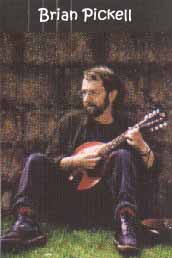
Brian Pickell, guitar, mandolin, vocals; Julie Schryer, piano; Pat O'Gorman, wooden flute, whistle, Uilean pipes; Ian Bell, guitar; Sahra Fetherstone, Irish harp, fiddle; Charlie Cares, vocals; Nathan Curry, cittern, mandolin, bodhran; Rob Graves, djembe, dumbeck, bongos; Kate Murphy, banjo, vocals; Shane Cook, fiddle; Brian Hebert, fiddle; Jon Pilatzke, fiddle, feet; Mark Sullivan, fiddle; James Stephens, fiddle, viola, bass; Pierry Schryer, fiddle; Dan Schryer, fiddle; Louis Schryer, fiddle; Geoff Somers, fiddle, mandolin
Produced by Brian Pickell, James Stephens, James Gordon; Engineers: James Gordon, James Stephens, Nathan Curry; Recorded at Pipe Street Studios, Guelph, ON - Stove Studios, Chelsea, QC - May - June, 2002
Tracks: Sulpher Creek* / Go Lie Down* / Champagne Breakfast* / Ray Couture*; Cheerful James* / Buttermilk Hill*; Muriel's Waltz* / Sourgrass and Granite* / Waiting for Emilie*; The End of Winter* / The Silversmith*; North Saskatchewan*; The Apprentice* / The Millwright's Daughter*; Pierre's Right Arm*; Benoit's Pool* / The French River Bridge*; Born of a Summer's Day*; Mulligan's Clog* / The Red Braid* / Iron Bob*; Côté's Corner* / Sandy Hook*; Nightbirds* / The Tenth of April* / The Boy Comes Home*; Coming Home*; My Father's Desk*; The Hiccup Jig* / Burnt River* / Leslie & Bibbs* / Three Day Blow* / Chasing Squirrels*
Sulpher Creek / Go Lie Down / Champagne Breakfast / Ray Couture - This creek runs through the farm of Conrad and Barb Grexton near Grandview, Manitoba. You have a dog ... you understand. The Champagne family of Montreal took us to their home at 3 AM, and then got up at 7:30 to make us breakfast for an early departure. Ray Couture, whom Kate and I loved to jam with at Pembroke, always conveyed elegance with a full heart with his fiddleCheerful James / Buttermilk Hill - James Stephens is a wonderful musician, recording engineer and person who somehow manages to be cheerful in a manner that is endearing, not obnoxious. Buttermilk Hill is a place in Southern Manitoba.
Muriel's Waltz / Sourgrass and Granite / Waiting for Emilie - Waltz till you drop. Muriel's is lovingly dedicated to my wonderful mother. Sourgrass is for longtime musical companion and incomparable friend, Julie Schryer. Her beautiful farm nestles against the Canadian Shield near Sault Ste. Marie, ON. It is a blend of meadows and forested granite outcroppings. My daughter Emilie is now a lovely seventeen year-old, but at the time I wrote this tune, she was a mystery, carried by Kate.
The End of Winter / The Silversmith - At the end of a particularly trying winter, this jig came with the first sweet days of spring. The second tune is for dear friend Karen, who is a silversmith.
North Saskatchewan - Immigrants often spend years wondering if they made the right decision, thinking about unfinished stories and longing for what they left behind. But for many, there is a moment of clarity in realizing that what they have created in their new world is now home.
The Apprentice / The Millwright's Daughter - These go back to the early days of hooking up with the Schryer family in fiddle parks, when we were all hot to play tunes. We still are. The first is for older brother Raymond, still a great fiddler, who was an apprentice violin builder. Now, his violins win medals worldwide. The second is for Julie Schryer, pianist extraordinare, whose papa Julien is a millwright.
Pierre's Right Arm - I've played with Pierre from the time he was a boy. In the 1990s, along with Nathan and Julie, we toured in North America, the UK and Ireland. This tune was composed to celebrate Pierre's wonderful bowing arm. This version happened spontaneously.
Benoit's Pool / The French River Bridge - On one hot summer visit to the Soo, I spent a great deal of time lounging in Julie's son Benoit's inflatable pool ... worthy of a tune. When traveling from the South, I always feel that I have entered Northern Ontario when I cross this beautiful old iron bridge. These tunes are sent with affection to the many Francophone players who have made such a great contribution to the tradition.
Born of a Summer's Day - The first few hours of labour to deliver her youngest son, Julie spent at the piano, with a house full of fiddle players and other musicians. My ex-wife Kate Murphy and I were fortunate enough to be there. The next day was more peaceful as Julie, five children, two midwives and the rest of us waited and ate and talked and joked quietly. The feeling in the room was magical and outside the insects were singing and the fields shimmered in the July sun.
Mulligan's Clog / The Red Braid / Iron Bob - Alex Mulligan was an educator, square dance caller and stepdancer, who learned and passed along steps from Bobcaygeon loggers and Toronto vaudeville dancers in the 1920s. Donna MacLeod is a great friend who possesses a red braid which is both very impressive and very dangerous if she is swinging on the dance floor. Bob Ranger could be found playing for stepdancers all day at competitions and then still playing for the joy of it in the campground at 2 AM. He taught, teased and inspired legions of players young and old. We miss you, Bob.
Côté's Corner / Sandy Hook - I was a Bluegrass musician in the 1970s and these tunes are inspired by that period and the playing of Kenny Baker. At the wonderful Pembroke Fiddle and Stepdance Competition, René Côté has resided at a prominent corner in the campground for as long as I can remember. In the evening, you could count on finding a hearty group of musicians, singers and listeners soaking up René's sweet and soulful bluegrass fiddling. Sandy Hook is a hamlet in Southern Ontario.
Nightbirds / The Tenth of April / The Boy Comes Home - This is for friends both ornithological and human who keep me awake with their tunes. The second tune was written for Kate's birthday ... three parts, no expense was spared. When our terrific son Martin was less than two years old, he had abdominal surgery. Any parent will understand how desperately happy we were on his return home.
Coming Home - This song is dedicated to my own relatives and all the others who were drawn into the soul-searing conflicts of the 20th Century, lived through the worst nightmares and were able to come back and restart their lives.
My Father's Desk - My father, Jack Pickell, was a much-loved small town newspaper editor, who worked for decades on a beautiful old carved desk, at which I am fortunate to be sitting as I write these notes.
The Hiccup Jig / Burnt River / Leslie & Bibbs / Three Day Blow / Chasing Squirrels - This started in the kitchen of Jerry Mulvahill and Mary Stauton (thank you, hospitable souls) near Galway and was finished in the Stromness Hotel in the Orkney Islands. Burnt River is a place near Pembroke. Leslie and Bibbs put us up in kind fashion when we played in Wales. When it blows hard on Lake Huron, it will often last three days. Chasing squirrels, a dog passion.
Big thanks to:
Kate, Emilie and Martin. I cannot imagine life without you. The musicians who all brought so much to this project. Julie and Pat, you were at the heart of it all the way through. The Pembroke Fiddle and Stepdance folks, for doing it right and for the many years of pure pleasure and inspiration found in that oasis of music and good times. Warren and Elinor and all the folks at the Goderich Celtic Festival for fostering the love, learning and performance of the music, for the years of inspiration and support. The whole Schryer family for all the wonderful music and great times, particularly Juliette and Julien for bottomless hospitality. James and James for your skill, patience, stamina and humour. Oliver Schroer, Ian Bell, Grit Laskin, and Bill Garrett for kind and patient counsel. Oliver for being such a great longtime philosopher-tune-buddy. Donna, Michelle and Clinton for singing my songs and encouraging me always. Julie Delahanty for warm hospitality and allowing me to kidnap Cheerful James. My dear friends, you know who you are, for the walks, talks, pints, stories, dinners and kind encouragement ... love to you all. To all the ones we love to love the music with and who inspire us. Some who are gone and some whom we have yet to meet. (I know there is someone or some entity that I have forgotten. Please forgive me.)
This work is happily dedicated to my parents, Jack & Muriel Pickell, for a lifetime of unfailing love and support.
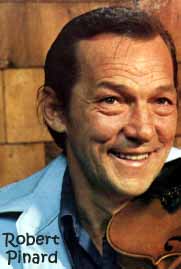
Gagnant concourse des Fêtes Populaires Soirées Canadienn ’76, Bonanza Levy B-29661 – 1976
Robert Pinard, violon
Ingénieur: Denis Aubin; Assistant: Yves Duquette; Directeur Technique: Julien Povencher; Edition: Levis Bouliane Inc.; Production: Levis Bouliane Inc; Enregistrement: Les Studios J.D. Inc.
Tunes: Reel de Trudeau; Reel de Grand-Père;
Le vieux Poêle; Valse Caroussel; Reel des montagnes Sauteuses; Valse
Marie-Anne; Polka Allemande; Reel du pavillon; Reel des trois lacs; Reel
esquimaux
See Compilations
Fiddling Through The Years - Championship Style, R-Tek RSP 101
See Compilations
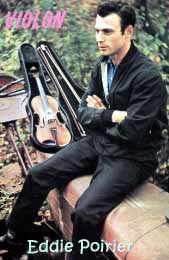
Maritime Fiddler or/ou Eddie Poirier et son Violon, Paragon ALS 157 or FALS 604
(two versions of this LP: one in English, l’autre en Français - ed)
Eddie Poirier, fiddle; Al Hooper, guitar; Doug Watters, bass; Roy MacCaull, mandolin
Produced by/ Réalisateurs par Jacques LaFleur et William Brassard
Tracks: Boil Them Cabbage Down or Bouilles Ton Chou; Golden Wedding Reel ou Le Reel des Noces D’or; Fishing Rod Reel or Le Reel de la Canne À Peche; Green Fields of Barrington ou Champs De Chez Moi; Back Up And Push or Débarques et Pousses; Ottawa Valley Reel ou Le Reel De La Vallée; Caribou Reel or Le Reel du Caribou; Kent County Jig ou La Gigue de Ti-Luc; Black Mountain Rag or La Montagne Noire; Cousin Bill Hornpipe ou La Pipe Du Cousin Bill*; Little Burnt Potato or Patates Brulées; Maple Syrup ou Le Sirop No. 2
(No French Liner Notes - ed)
When Eddy Poirier was seven years old he entertained the folks playing fiddle in Rogersville, New Brunswick.By the time he reached his teens, he was an accomplished musician in all of the stringed instruments: Banjo, guitar, mandolin, fiddle and bass. He also ‘gets by’ on harmonica and accordion.
Today, after winning many championship trophies for fiddle, he plays bass with The Blue Diamonds: Al Hooper, Doug Watters and Roy MacCaull.
Included in this album is Eddy’s first original song, “Cousin Bill Hornpipe” dedicated to ‘Cousin Bill’ of CBC radio and television.
Tracks: Lord McDonald’s Reel; Frankie’s
Favourite; Maritime Jig; Cousin Bill Hornpipe*; Scottish Medley; Gaspé
Reel; Salute To Cape Breton Island; Watching the Clock*; Big John McNeil
& The Dusty Miller’s Reel; Faded Love; Heather On The Hill; High Level
Hornpipe
Ladies and Gentlemen, we take pleasure in announcing a command performance performed by Edward Poirier, Esquire.Monsieur Poirier, a veritable virtuoso of the violin has honoured us by gracing the grooves of this recording with such well known and beloved classics as “Watching the Clock”, “Faded Love” and the ever popular “Cousin Bill Hornpipe”.
Those and other selections, through the dazzling dexterity of the maestro’s nimble fingering bring these and other selections once more to musical flower.
For it is well known in musical circles that Maestro Poirier is regarded as the leading exponent of down-east fiddle music having performed before the crowned heads of the Maritimes, not to mention his many successful tours throughout the provinces.
It is indeed with pride that we are able to present to you this multi-talented musician giving what must be regarded in all humility as his finest recording to date.
Jack Hosier
Eddie Poirier, fiddle; Graham Townsend, piano
Produced 1973
Tracks: Pet of the Piper / Harper's Fancy; Donigal Hornpipe / Sandhill Hornpipe; Seige of Innis; Lord Albert Jig*; Moon Coin / Paddy Cronin's Reel; Hughie Shortie's Reel / Walker St. Reel; Sheehan's Reel / Paddy on the Turnpike; French Reel; Reeve's Reel; When The Kettle Boils Over / The Lark In The Mornin; The Tea Thoddler Reel; Mora Shein Reel / Capre Phe
It may seem strange that someone with a name like Poirier would set down 12 selections of Irish, Scottish and Cape Breton fiddle style music.Not so. Eddie Poirier, born and raised in the Maritimes, is well acquainted with the regional music of the area. The proof of which lies within this album jacket.
Ed has been entertaining audiences for about as long as he can remember. Always a favourite with the crowds, whether it be on drums, banjo, accordion, bass, flat-top and of course the fiddle, of which he has picked up many a Championship trophy over the years.
Since moving to Ontario, Ed has established himself as a name artist of national renown through the many variety of albums he has recorded over the past few years. He is also in constant demand as a backup musician at recording studio sessions in Toronto. Country fans right across Canada have watched this extremely versatile musician perform on such national televised programmes as "Countrytime" and "The Ian Tyson Show" and on New York's televised Telethon for crippled children as well as stage, radio and TV appearances and interviews too numerous to mention.
On the Irish - Scottish - Cape Breton album, you'll find Eddy Poirier at his fiddlin' best. A truly fine selection of tunes including on of Eddy's own compositions "Lord Alberg Jig" written especially for this album.
Ed would like to take this opportunity to dedicated this album to his many loyal fans right across Canada
See Compilations

French Canadian Fiddling, Buckshot Records BT-9006 - 1973
Tunes: Le Reel des travaillants de la mine - Noranda Mine Worker's Reel; Le Reel de Macamin - Macamic Reel; Le Reel de ma soeur - My Sister's Reel; Le Reel du Bourreau - Hangman's Reel; Le Reel de la Pointe Au Pic - Pointe Au Pic Reel; Le Reel de St. Isidore - Ste. Isidore's Reel; L'Oiseau Moqueur - Mocking Bird Hill; Le Reel du montagnard - Mountaineer's Reel; La Matelote du carnival d'hiver - Winter Carnival Hornpipe; La Fille que j'ai laissee - The Girl I Left Behind; La Matelote de Liverpool - Liverpool Hornpipe; Le Reel de la vitre brissee - Smash The Window
Gaétan Poirier maîtrise son violon au style français, et quel joueur!Prince Edward Island FiddlersSon style unique de taper du pied, lorsqu'il joue, lui donne un son Candien, distinct.
Le long jeu de ses chansons, le catégorise "superbe", dans la musique Canadienne Français. C'est un extrème plaisir pour moi de faire connaissance de Gaétan, un natif de St-Hubert (Comté Temis Kuata, Québec), et je peux dire que cet individu m'a donnéune forte impression de son talent et de sa saveur rurale presentée dans sa musique.
Son album instrumental, je suis certain va plaire tou auditeurs "Country". Gaétain Poirier joue son violon "Du bon vieux Temps", et quel joueur!!!!
Gaétain Poirier, is a French Style Fiddle Player; is a Fiddle Player!
The unique style of foot stamping fiddle playing is a distinctive French Canadian sound that is unmistakable.
This long play album of songs has to be definitely rated in the super category of kFrench style fiddle. It was my pleasure to become acquainted with Gaétain Poirier, a native of St. Hubert Compté Temis Kuata, Québec, a short time ago and I must confess that since that time I have become increasingly impressed with the talent this man displays and the rural flavour his music portrays.
This is an instrumental album that I am sure will delight every Country Music Fan - bud don't just take my word for it - listen yourself and you can be the judge.
Gaétan Poirier, is a French Style Fiddle Player; is a Fiddle Player!
Murray Hunt
St. Catherines, Ontario
Glendale ‘79 Live, Inter Media
Services IMS-WRC1-1273 - 1979
See Compilations
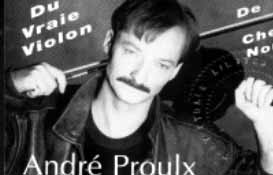
Du Vraie Violon De Chez Nous, Ultime Alliance UA-210
Tunes: Reel du Diable; Reel du pendu; Valse
des voltigeurs; Gigue simple; Reel de Sherbrooke; Reel de St-Jean; Set
Carré traditionnel non callé; Medley pour vous faire danser
et swinger